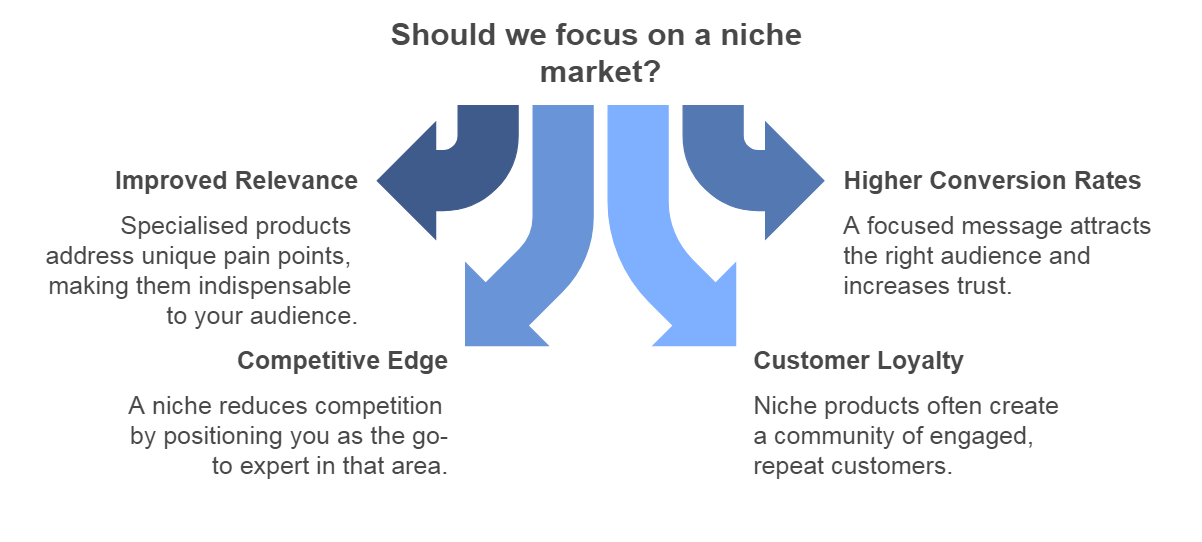Identifying Profitable Niches for Your Digital Product Business
Start Unlocking Your Success
Building a successful digital product business starts with one foundational step: identifying a profitable niche. This process is not about guesswork; it’s about a strategic exploration of opportunities that align with market demand, audience needs, and your unique expertise.
In this guide, we’ll break down how to research, evaluate, and refine your niche to set the stage for sustainable success.
Understanding Market Niches: Why Specialisation Matters
Focusing on a specific niche allows you to cater to well-defined audience segments, offering targeted solutions that resonate deeply. Here’s why niching down is key:
Improved Relevance: Specialised products address unique pain points, making them indispensable to your audience.
Higher Conversion Rates: A focused message attracts the right audience and increases trust.
Competitive Edge: A niche reduces competition by positioning you as the go-to expert in that area.
Customer Loyalty: Niche products often create a community of engaged, repeat customers.
Real-World Example 1:
Consider the fitness industry—a vast and competitive market. Niching down to “virtual fitness programs for postpartum mothers” positions you as a specialist who understands and solves a unique challenge, building trust among this demographic.
Real-World Example 2:
In the digital art space, offering “customizable templates for tech start-ups” differentiates you from generic design services and aligns perfectly with a specific, profitable audience.
Researching Market Trends: Tapping into What’s Hot Now
Market research is essential for uncovering profitable niches. Utilise these tools and techniques to identify what’s trending:
Google Trends: Monitor interest levels over time to spot long-term growth niches.
Social Media Platforms: Search hashtags, follow industry influencers, and analyze viral topics.
Forums and Communities: Explore Reddit, Quora, and niche-specific forums for pressing questions and unmet needs.
Industry Reports: Analyse reports to validate market demand and identify emerging opportunities.
Key Tips:
Look for niches with consistent growth over time rather than short-term spikes.
Identify gaps in the market where existing solutions fall short.
Defining Your Target Audience: Finding the People Who Need You Most
Understanding your audience is crucial for tailoring products to their needs. Start by building a detailed customer persona that includes:
Demographics: Age, gender, income, education, and location.
Psychographics: Interests, values, lifestyles, and buying behaviours.
Pain Points: What problems do they face that your product can solve?
Steps to Define Your Audience:
Conduct Surveys: Use tools like Google Forms or Type form to gather direct feedback.
Analyse Competitor Audiences: Identify who they’re targeting and what’s working.
Build Personas: Create fictional profiles of your ideal customers to guide decisions.
Real-World Example:
A tech-savvy audience looking for digital planners might prefer features like cloud syncing and automation. Catering to these expectations can elevate your niche product.
Evaluating Competition and Demand: Balancing Opportunities
Choosing a niche isn’t just about what excites you—it’s about ensuring there’s room for profitability. Evaluate competition and demand with these strategies:
Keyword Research: Use tools like Ahrefs or SEMrush to identify high-demand, low-competition keywords.
Analyse Competitors: Study their products, pricing, and customer feedback to uncover gaps.
Estimate Market Size: Validate demand using industry reports and online reviews.
Key Tips:
High competition with poor customer reviews signals opportunities for improvement.
Low competition with minimal demand might indicate a weak niche.
Moderate competition with growing demand is often the sweet spot.
Real-World Example:
An analysis of YouTube educational channels revealed a demand for courses on “3D modelling for indie game developers,” a niche undeserved by current offerings.
Refining Your Niche: The Power of Narrowing Down
Once you’ve done your research, it’s time to refine your niche. Narrowing down allows you to craft a highly focused product and message. Here’s how to do it:
· Specialise Further: Focus on a micro-segment within a broader market.
· Solve Specific Problems: Identify one challenge your product can uniquely address.
· Combine Interests: Blend niches for a creative and targeted solution.
· Instead of “digital marketing,” target “Instagram strategies for local bakeries.”
· Rather than “online fitness,” specialise in “yoga for seniors with limited mobility.”
Real-World Example 1:
A broad parenting niche can be narrowed to “eco-friendly baby products for millennial moms.” This refined focus aligns with their values and preferences.
Real-World Example 2:
A general photography niche can transform into “budget-friendly gear guides for travel photographers,” addressing a specific need while reducing competition.
Actionable Steps to Start Identifying Your Niche Today
1. Brainstorm Interests: List your passions and areas of expertise.
2. Research Trends: Use Google Trends and social media for insights.
3. Survey Your Audience: Gather input to validate ideas.
4. Analyse Competitors: Identify gaps in their offerings.
5. Test Your Ideas: Launch a minimum viable product (MVP) to gauge demand.
FAQs:
❓ Why is identifying a niche so important?
Focusing on a niche ensures that your product stands out, connects with the right audience, and addresses specific needs, driving higher sales and loyalty.
❓ How do I know if a niche is profitable?
Look for growing demand, limited competition, and audience willingness to pay for solutions in that niche.
❓ What tools are best for researching niches?
Google Trends, social media insights, keyword tools like SEMrush, and industry reports are invaluable for research.
❓ Can I target multiple niches?
It’s best to start with one niche to establish expertise. Once successful, you can expand into related areas.
❓What’s an example of a successful niche?
“DIY home organisation for small apartments” is a highly specific niche catering to renters seeking practical, affordable solutions.








